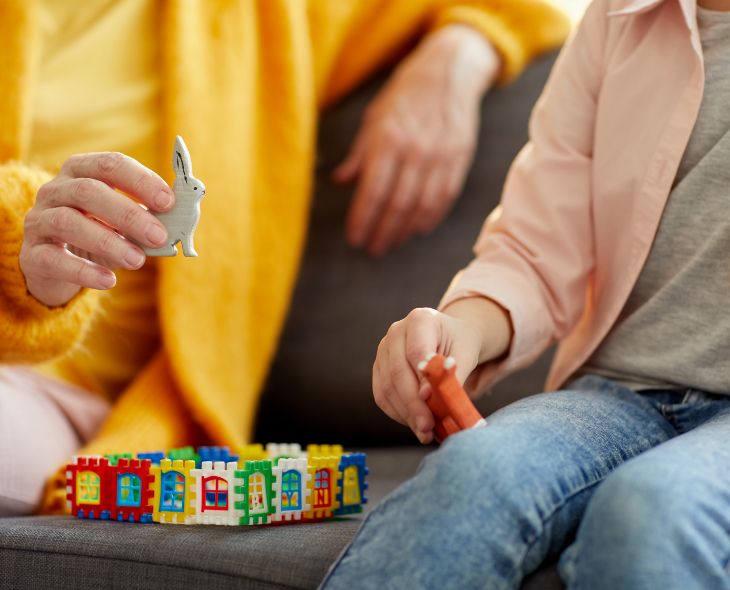How to ensure that accurate and timely child welfare data is available in Texas.


How to ensure that accurate and timely child welfare data is available in Texas.
The number of children and families in Texas that need child abuse and neglect protection and support.
A breakdown of the benefits of Family Connects across Texas.
Dallas – Last week was hard for all of us; it was heartbreaking and traumatizing for Texans. We hope you and your loved ones are faring well after what seemed like a week that would never end.
As the beautiful weather ushers out the intense cold of last week, many of us are fortunate enough to put these hardships behind us. While many of us can ease back into some stability and normalcy, maybe with an anecdotal story about the hardships or inconveniences we experienced, they are likely different than the stories of families that were in an existing storm of what surely feels like insurmountable challenges.
Too many Texans who are already experiencing a too-wide disparity gap and who have been disproportionately affected by COVID-19 will see the aftermath of the winter storms compound already record-high levels of stress and trauma.
This crisis reminds us there is a clear and urgent need to put children and their families first in this legislative session.
We need to ensure the immediate safety and protection of children who are survivors of child abuse and neglect. We must work with the Legislature on smart solutions to invest in upstream programs that prevent child abuse and neglect and mitigate the negative impact of events like Winter Storm Uri.
Although Texas families are experiencing back-to-back, once-in-a-lifetime events, we at TexProtects recognize that these hardships do not define families nor lead to child abuse. But what we do know is that thousands of little precious lives and families need our help and support more than ever. It’s our collective responsibility to ensure we have networks in place for families to turn to.
Here are ways you can help:
families in need.
the aisle for the common good of children and the state. You can even share
your own story!
Thank you for your support and your dedication to helping us build safer childhoods for all children to secure Texas’s future.

The best way to get policymakers to make the changes we need to protect children and families is to provide them with evidence that proves investing in prevention works. Not only will our state finances see the benefits but so will Texas children at risk of abuse and neglect. Jennifer Lucy, our Managing Director of Policy, submitted the public testimony below to the House Appropriations and Senate Finance Committees proving that investing upstream works; it saves dollars and makes sense!
By Jennifer Lucy, Managing Director of Policy for TexProtects, on Article II budget for FY 2022-2023.
TexProtects is the only statewide organization singularly focused on the prevention of child abuse and neglect, and we serve as the Texas Chapter for Prevent Child Abuse America and as a steering committee member for the Texas Child Protection Roundtable and Prenatal to Three Collaborative. We applaud the maintenance of prevention funding in the base budget and appreciate the work of this committee in ensuring that the health and well-being of the next generation remain primary in our approach to COVID-19 response and recovery.
Texas has an opportunity to use what we learned during COVID-19 to transform systems in ways that support families, rather than removing children, and roll out proven prevention strategies BEFORE a crisis. Like any smart investor, it’s critical that we pay for the outcomes we do want rather than those we don’t. This requires a shift upstream and will result in downstream cost savings across multiple systems for decades to come as today’s children grow up to be the strong Texas of tomorrow.
The cost of the status quo and inaction is clear. Adverse Childhood Experiences (ACEs) like child abuse and neglect are associated with negative outcomes for individuals across the lifespan including poorer health, lower educational attainment, and higher likelihood of experiencing unemployment. Individuals and governments incur significant costs as a result. Bellis et al. (2019) estimate that annual costs attributable to ACEs across North America are approximately $748 billion with 82% of the costs resulting from individuals who had two or more ACEs.[i] With one in 10 American children living in Texas, we can expect to incur a significant percent of those costs if we are not better able to prevent ACEs.
Healthcare costs are the most well-documented, but there are also criminal justice, child welfare, and education costs, among others. Each case of child abuse or neglect results in $830,000 in costs across the victim’s lifetime.[ii] This translates to over $55 billion in costs as a result of confirmed abuse and neglect in Texas in 2019 alone. We can continue to pay for the effects of childhood adversity, or we can work to prevent it.
TexProtects worked with Child Trends to look specifically at the potential impact of COVID-19 on child abuse and neglect risks and found reason to believe that increases in unemployment, mental health struggles, family violence, substance use issues, and parental stress may result in increased abuse and neglect. Research during the last recession found that for each point the unemployment rate rises, physical and emotional abuse increase by 12-15%.[iii]
However, with the large majority of Child Protective Services (CPS) cases addressing neglect rather than abuse and much abuse/neglect going unreported, we know families need support more often than they need protection. The most cost-efficient and effective approaches offer supports BEFORE A CRISIS occurs and during the first years of life when a stable, safe, nurturing caregiver is THE KEY to healthy child development.
The 87th legislature can increase access to proven support strategies that protect children by implementing the following recommendations in the 2022/2023 budget for Texas.
Proven prevention programs administered through the Prevention and Early Intervention (PEI) division at the Department of Family Protective Services (DFPS) have been critical lifelines for families during COVID-19 and depend on an infrastructure of community providers who work together to support families. Over the past decade, state and federal investments have helped build community-driven prevention infrastructure that accelerates the work of local nonprofits to deliver parenting support, information on local resources, and health screenings to children and their families. These voluntary programs have a proven return on investment of between $1.26 and $8.08 and have impacts across multiple domains and two generations. [iv]
Only 4% of the families in highest need currently have access, therefore, expansion is critical if Texas desires the statewide impact and cost savings that could result from widespread access to these programs. The current PEI strategic plan indicates that to adequately protect families, a 20% increase in prevention funds is needed every biennium. Currently, DFPS only spends 5% on early prevention efforts compared to CPS costs.
Texas must be proactive and innovative in determining how to maximize the opportunity of the Family First Prevention Services Act (FFPSA) to access federal matching funds for prevention funding that can be used to directly address the key drivers of child abuse/neglect: substance use, mental health, and parenting skills. With the large majority of CPS cases addressing neglect rather than abuse, we know families need support more often than they need protection. As noted by the DFPS 2018 Prevention Task Force Report, “Preventing 3% of removals (593) would save upwards of $20.3 million.”
Use of these funds should be prioritized for evidence-based programs that will prevent entry into the foster care system as this is the primary way to ensure better outcomes for children, family preservation, and long-term cost savings for the state.
The current plan provided by the agency proposes that $33.9 million of the $50.4 federal transition funds go toward prevention. All prevention strategies recommended here rely on community contracts rather than staff who work for DFPS.
Option 2D (A pilot for prevention services carried out by DFPS’ PEI division): PEI offers services to families to prevent child abuse and neglect. Their efforts focus mainly on primary prevention, which aims to reach families before the first occurrence of child maltreatment. However, some of their programs also focus on secondary prevention, which targets families who are at high risk of child maltreatment, such as families participating in Family-Based Safety Services (FBSS). Grants would be awarded to up to six regions. One community contractor would receive the grant in each region and then decide which programs to fund and deliver either through their own services or those of local subcontractors.
Option 2E (Expand HIP [Helping through Intervention and Prevention] for all pregnant and parenting foster youth):HIP is an effective program through PEI that serves current and former foster youth who are pregnant or parenting a child under the age of 3 by providing in-home parent education services. Additional funds would allow expansion of these voluntary support services.
These options focus on strategies that are evidence-based and have shown that they can keep children safe and reduce child maltreatment. They also already have an established and successful infrastructure. Some of the programs also have experience serving families participating in FBSS, who fit the eligibility definition and have already been approved by the Clearinghouse, including Healthy Families America, Nurse-Family Partnership, and Parents as Teachers.
The other options presented by DFPS would require a great length of time before they could be implemented (i.e. carrying out prevention services through Community-Based Care) or would be relying on FBSS caseworkers to deliver programming that is outside their area of expertise and/or credentialing requirements. Both would require significant deviation for systems and staff and potential conflicts of interest or complexities that do not make it feasible.
In 2009, the Texas Legislature passed Senate Bill 2080 to establish the MedCARES grant program as part of a strategic response to growing numbers of child abuse and neglect-related fatalities. The bill was championed by Senator Jane Nelson with the help of now Lieutenant Governor Dan Patrick; Representatives Garnet Coleman, Tan Parker, Toni Rose, Rafael Anchia, and Abel Herrero; and now Senator Jose Menéndez.
MedCARES provides grant funding to hospitals, academic health centers, and facilities with expertise in pediatric health to prevent, assess, diagnose, and treat child abuse and neglect. MedCARES grant recipients give communities easy access to medical providers who support education for the general public, case reviews for other physicians, trainings, and expert courtroom testimony by child abuse specialists. MedCARES providers include general pediatricians, child abuse pediatricians (CAPs), nurse practitioners, social workers, and sexual assault nurse examiners.
COVID-19 has exacerbated child abuse risks due to increased family stress, increased substance use, and heightened economic insecurity. Cutting MedCARES compromises critical infrastructure we have in place to protect children in Texas. Last year alone, almost 22,000 professionals attended child abuse prevention trainings through MedCARES and more than 2 million individuals participated in prevention program activities.
Thank you for your attention to these critical investments that not only support families and protect children today–but ensure a brighter Texas tomorrow.
We look forward to working with you. Please contact us anytime if we can provide support or resources as you address these and other child protection issues.
Jennifer Lucy
Managing Director of Policy
512-971-9347
Members of our Advisory Board include:
The Hon. Darlene Byrne, J.D. | Rebel Calhoun | Leslie Carpenter | John Castle, Jr., J.D. | Leslie DeCillis Debra Decker | The Hon. Maurine Dickey | Catherine Estrada | Robert Estrada | Kathleen Fletcher, Ph.D. Laura Gardiner | Tammy Cotton Hartnett | The Hon. Lee Jackson | Scott Murray | Len Musgrove
Janet Pozmantier, MS, LPC | Dick Rogoff | The Hon. Peter Sakai, J.D. | The Hon. Florence Shapiro
Lisa K. Simmons | The Hon. Mark Strama | The Hon. Royce West, J.D.
About TexProtects
TexProtects’ mission is to protect Texas children from the trauma of abuse and neglect and empowers families to thrive through education, research, and advocacy. Our vision is that all children are safe, nurtured, and resilient. To achieve our mission, TexProtects engages in research, advocacy and education. We advocate for better policies, reforms and appropriate increases in federal, state and local funding for three priority areas: 1) Prevention: Increasing investment in proven child abuse prevention programs, 2) Protection: Strengthening and reforming the CPS system, and 3) Healing: Ensuring victims receive adequate and accessible treatment.
[i] Bellis et al (2019)
[ii] Peterson et al (2018)
[iii] Schneider, W., Waldfogel, J., & Brooks-Gunn, J. (2017).
[iv] : Prinz, R. J., Sanders, M. R., Shapiro, C. J., Whitaker, D. J., & Lutzker, J. R. (2009); Chaffin, M., Hecht, D., Bard, D., Silovsky, J. F., & Beasley, W. H. (2012). DuMont, K., Mitchell-Herzfeld, S., Greene, R., Lee, E., Lowenfels, A., Rodriguez, M., & Dorabawila, V. (2008); Olds, D. L., Kitzman, H. J., Cole, R. E., Hanks, C. A., Arcoleo, K. J., Anson, E. A., . . . Stevenson, A. J. (2010); Olds, D. L., Kitzman, H., Hanks, C., Cole, R., Anson, E., Sidora-Arcoleo, K., et al. (2007); Olds, D. L., Robinson, J., Pettitt, L. M., Luckey, D. W., Holmberg, J., Ng, R. K., . . . Henerson, C. R. (2004)

“During the COVID-19 pandemic, the number of families experiencing hardships across the country has risen dramatically, with a disproportionate impact on Latino and Black communities.… For the analysis presented in this brief, we used nationally representative data from the Census Bureau’s Household Pulse Survey, which has tracked the well-being of U.S. households during the pandemic, to examine seven types of hardships: unemployment, difficulty paying expenses, not being caught up on rent or mortgage, food insecurity, physical health problems, symptoms of anxiety or depression, and lack of health insurance.”

TexProtects Takeaway: The hardships brought on by COVID-19 affecting Black, brown, and indigenous families trickle down to their children. Issues like economic distress, food insecurity, and mental health challenges, exacerbated by the pandemic, impact how families can care for their children during this crisis and in the future. This places more stressors on caregivers, who are less able to help children cultivate the protective factors and resilience that help mitigate adverse experiences in childhood. To read more from TexProtects about the disproportionate impact on these families during COVID-19, click here.
2. Strategies to Virtually Support and Engage Families of Young Children during COVID-19 (Child Trends)
“As preschools and schools continue to reopen, caregivers (e.g., childcare providers and teachers) are quickly pivoting to using virtual platforms to support and engage families in children’s learning. This rapid transition has left little time to assess what we know (and do not know) about family engagement best practices within the virtual space. This brief offers an overview of four best practices and lessons learned from research and practice to assist caregivers and teachers with the transition to engaging families virtually during the COVID-19 pandemic, and beyond.”

TexProtects Takeaway: Virtual learning can be a strain on parents and children’s mental health and time. It is imperative that caregivers and teachers use all the tools necessary to ensure education and resources are provided in the least intrusive, most beneficial ways possible to ensure children, especially those at the critical ages of 0-5, are getting what they need out of virtual learning and early childhood experiences.
3. Buffing Child Maltreatment: School Connectedness as a Protective Factor in a Community Sample of Young Adults(Goldstine-Cole, K.)
“Identified or not, maltreatment increases the risk for substance use disorder, depression, anxiety and post-traumatic stress disorder across the lifespan. This study examines whether school connectedness (SC), the sense of belonging at school derived from affective relationships in the school context and commitment to learning, protects against such effects. Specifically, in paper one, data from 349 young adults who completed the Protective Factor Questionnaire is used to develop a retrospective five-indicator, measurement model of school connectedness for K-12 and elementary, middle, and high school.… Paper two evaluates SC as a moderator in the relationship between childhood maltreatment and mental well-being during early adulthood, ages 18-25. Results indicate that SC buffers against intrafamilial maltreatment as well as five individual forms of abuse and neglect.… These results suggest that schools have roles beyond that of mandatory reporter in supporting the wellbeing of maltreated children.”

TexProtects Takeaway: Child abuse and neglect numbers may have risen during the pandemic and schools’ closures, despite fewer reports. Teachers and school staff are one of the main reporters of abuse and neglect, and with the move to virtual learning for many, picking up on the signs is more difficult. TexProtects is working to spread awareness in schools about staff intervening in abuse or neglect, not just as mandatory reporters. See our resources on recognizing abuse on our website.
4. Trauma-Informed Care in Child Welfare: An Imperative for Residential Childcare Workers (Brend, D. & Sprang, G.)
“Rates of traumatization among residential child welfare professionals are alarmingly high. The well-being of these professionals is associated both with their intention to stay in their jobs and outcomes of children in their care.… This manuscript details experiences empirically shown to have potential negative impacts on professional well-being, discusses why these impacts are of particular concern for residential childcare workers, and describes the types of organizational cultures and climates that appear to mitigate these negative impacts. Trauma-informed care at the organizational level is proposed both as a means to reduce harm to child welfare professionals and promote the rehabilitation of children within the child welfare system.”

TexProtects Takeaway: Organizations and agencies working with children from hard places need to implement trauma-informed care training for all staff. Not only does training help mitigate secondary trauma of professionals, but it also helps professionals best serve the children they are working with. TexProtects worked on HB18 last session to ensure school staff receive trauma training; however, Texas has more work to do to ensure high quality training and implementation are consistent across all sectors that impact children and families.
5. AGED OUT: How We’re Failing Youth Transitioning Out of Foster Care (Cancel, S., Fathallah, S., Nitze, M., Sullivan, S., & Wright-Moore, E)
“To understand the aging out experiences of foster youth, Think Of Us and Bloom conducted in-field discovery sprints using proven human-centered design and participatory research methodologies in five participating locations” (Santa Clara, Solano, San Francisco, and San José counties in California, Hennepin County in Minnesota, and New York City). “During these sprints, we spoke to a total of 206 people in 92 research sessions. The research team conducted in-depth interviews and participatory design workshops with a wide range of foster youth, former foster youth, child welfare staff and leadership, supportive adults, foster parents, and more…Over the course of the project, three key themes began to emerge. To us, these themes represent where the child welfare system is most failing transition-age youth, and where we must urgently focus our attention. These themes are: 1. Healing and dealing with trauma; 2. Centering youth in their preparedness; and 3. Helping youth build a supportive network.”

TexProtects Takeaway: The state must not forget the needs of youth transitioning out of the foster care system. TexProtects is supporting our partners’ work this legislative session to support improved services for transitioning youth. Check out our bill tracker to learn more.
6. Why Do We Focus on the Prenatal-to-3 Age Period? Understanding the Importance of the Earliest Years (Prenatal-to-3 Policy Impact Center at LBJ School of Public Affairs, University of Texas at Austin)
This research brief discusses why researchers and practitioners in early childhood consistently describe the first few years of life as being the most critical period for children’s development. The authors highlight that investing in families during a child’s earliest years can have a lasting impact on children’s lifelong health and well-being. They point to key practices that can strengthen families, and therefore, promote the healthy development of children. Some of these factors include access to quality health care for mothers, safe and supportive childcare settings, and other social services, such as early intervention programs for children with developmental delays or disabilities.

TexProtects Takeaway: TexProtects is part of the Prenatal to Three initiative alongside our partners Children at Risk and Texans Care for Children. We support investment in increasing the following for low-income mothers and infants and toddlers: access to prenatal and postpartum health services; health screening and successful connection to necessary services; and access to high-quality childcare programs. Read more about the initiative.
7. Three Trimesters to Three Years: Promoting Early Development (Princeton University and the Brookings Institution)
“The period from pregnancy through age three is the one in which the most rapid growth of the brain and behavior occurs. Yet most researchers and policy makers have treated the nine months of development during pregnancy separately from the first three years of life. Prenatal experiences are part and parcel of the postnatal experience of mothers and their babies; the postnatal period is sometimes referred to as the fourth trimester, a way to highlight the fact that after a child’s birth, mothers themselves need continuing services and screening. Indeed, children’s wellbeing very much depends on their mothers’ health and wellbeing. The title of this issue of the Future of Children, “Three Trimesters to Three Years,” highlights continuity in development, the continuing intersection of mother and baby, and the rapid growth that occurs from conception to three years of age.”

The prenatal and postnatal periods are critical to a child’s health and development. We advocate for investment in home visiting programs that support families in nurturing their children’s development and resilience from an early age, such as Family Connects and Nurse-Family Partnership. Read more on home visiting programs.

The 87th Texas Legislative Session is underway, and both the House and Senate have released their proposed budgets for the upcoming 2022-2023 biennium. With more revenue available than expected, the Department of Family and Protective Services (DFPS) fared pretty well when compared to other Health and Human Services agencies in the Article II budget. While the two chambers had different approaches to spending, they both proposed providing DFPS with a total of $4.4 billion in All Funds, including over $13 million in General Revenue.
The best news in the DFPS budget is that prevention funds were maintained and, in some cases, strengthened in both the House and Senate base budgets. Increased federal funding as well as efficiencies in Prevention and Early Intervention Programs (PEI) resulted in slight increases to the STAR program, child abuse prevention grants, and home visiting programs. As prevention programs have been especially vulnerable in prior recessions, this is great news for the start of the 87th session as we continue to advocate for strategic growth and smart investments in prevention.
Unlike prior sessions, the House and Senate budgets begin with a host of similarities. Unfortunately, in general, many of those similarities reflect a maintenance of the status quo. Both chambers introduced budgets that fail to make meaningful investments to improve:
And in some cases, the budgets are aligned in ways that could result in decreased quality in DFPS operations. For example,
Despite being overwhelmingly similar, there are some key differences in the House and Senate budgets.
The budget is the single most important piece of legislation each session and is the only task that the legislature is required to complete. Lawmakers’ priorities and funding decisions determine if agencies will be able to provide appropriate and timely services and ensure the best outcomes. Members of the House and Senate still have work to do to reconcile the differences between their proposed budgets and consider what is most important for the safety and well-being of children and families. We encourage you to get involved in the House Appropriations and Senate Finance process as they continue to determine what the budget will look like for the upcoming biennium. The Senate Finance Committee will be hearing invited testimony on February 25th and allowing public comment on March 1st. It is critical that we encourage lawmakers to invest in the health and success of children and families by educating legislators on what works, what doesn’t, and the benefits of investing in smart solutions.
For guidance and resources on how you can champion child protection this legislative session, visit our website and sign-up to receive our advocacy alerts by texting TEXPROTECTED to 25994.

The 87th Legislative Session is underway, and with it comes the opportunity to fight for smart solutions to child abuse and neglect. Now more than ever, the TexProtects policy team is laser-focused on strategies that strengthen families, prevent child abuse, and promote healing during these times of exponential need.
COVID-19 has dramatically impacted our already vulnerable child protection system, put unimaginable strain on families with young children, and exacerbated root causes of child maltreatment like substance use and behavioral health concerns. 5,300 more children may be at risk of entering the Texas foster care system as a result and many more will be impacted. Texas cannot afford that additional $4.4 billion price tag nor can our children. Texas must invest in proven programs that prevent abuse and save $1.26-$8.08 per $1 invested by supporting community and family efforts to create safe and nurturing environments for the 7.5 million children who call Texas home. Together, it is time to do more of what works and less of what doesn’t for Texas children and their families across party lines. [link full agenda]

Sophie Phillips, TexProtects CEO, has a background in social work. Her passion and interest are in addressing the root causes of child abuse and neglect and creating partnerships to advance state policies and practices.

Jennifer Lucy, Managing Director of Programs, provides leadership, strategy, and coordination for TexProtects policy, research, education activities, and staff. She partners with legislators, staff, and community partners to execute a policy agenda that prevents child abuse and neglect and helps families thrive.

Kerrie Judice, CPS Researcher and Analyst, monitors key CPS and Foster Care issues for the team. Her prior experience as a worker in the CPS system and connections to other child protection partners provides invaluable insight as she advocates for improvements to the Texas child protection system.

Michelle Wittenburg is an external lobbyist whose strategic consultation and connections to the movers and shakers in the Capitol are an invaluable resource to TexProtects.

Jess Trudeau serves as the Director for the Texas Prenatal to Three Collaborative while providing coordination and direction for policy, advocacy, and funding efforts to support Family Connects.

Beth Cortez-Neavel provides organizational and administrative support for the policy team. She uses her journalism background to communicate the most important issues for child protection advocates.

Gloria manages communications strategies for TexProtects and the Texas Prenatal to Three Collaborative. Her goal is to connect the community to our policy recommendations and educational resources.
Safeguarding today’s children from abuse and neglect is essential to protecting tomorrow’s Texas. If you want to get involved in the process, we put together the six ways you can take action today. Visit [link https://www.texprotects.org/legetoolkit/ ] to view the list. The TexProtects team is committed to resourcing you well to use your voice to be a champion for children. Please don’t hesitate to contact our team with questions. We are here for you!

“In this brief, Child Trends examines the prevalence of children and youth with special health care needs (CYSHCN) in the foster care system. CYSHCN have—or are at increased risk for—chronic physical, developmental, or behavioral/emotional conditions. This brief provides an overview of the literature on CYSHCN and their experiences in the foster care system, a detailed explanation of the methodology used for the current brief, an explanation of our findings, and a brief discussion of practice and policy implications.” A key finding of this research suggests that “children and youth’s reasons for entering foster care, their experiences while in care, and their reasons for leaving care vary depending on whether they have an SHCN.”

TexProtects Takeaway: 18% of children in Texas foster care have special health care needs with older youth and Black or Hispanic children having a higher likelihood of having an identified special health care need. These children come into foster care for different reasons than their peers and have different experiences and needs. More must be done to identify which placements and strategies are available and needed to best ensure their safety and success in care.
This feature of the MMWR features research on national child maltreatment reports during eight months of the global pandemic. Findings suggest that during COVID-19, “the total number of emergency department visits related to child abuse and neglect decreased, but the percentage of such visits resulting in hospitalization increased, compared with 2019. The pandemic has affected health care–seeking patterns for child abuse and neglect, raising concerns that victims might not have received care and that severity of injuries remained stable or worsened. Implementation of strategies to prevent child abuse and neglect is important, particularly during public health emergencies.”
3. The Neglected Ones: Time at Home During COVID-19 and Child Maltreatment (Bullinger, L., Raissian, K., Feely, M., & Schneider, W.)
“We combine early release child maltreatment reports in Indiana with unique and newly available mobile phone movement data to better understand the relationship between staying at home intensively during the COVID-19 pandemic and child maltreatment. Our findings indicate that the prolonged stays at home promoted by the public health response to COVID-19 resulted in reductions in child maltreatment reports overall and in substantiated reports of maltreatment. However, relative to areas that stayed home less, children in areas that stayed home more were more likely to be both reported for and a confirmed victim of maltreatment, particularly neglect. These areas have historically been socioeconomically advantaged and experienced lower rates of maltreatment. We only observe increases in confirmed child maltreatment in metropolitan counties, suggesting that the effects of staying home on child maltreatment may reflect both the differential risk of leaving home and access to services in metropolitan–rather than non-metropolitan–counties.”

TexProtects Takeaway: Despite the decreases in reports during the earlier months of COVID-19, research supports an assumption that the stresses of COVID-19 on families is likely increasing the risk of child maltreatment. TexProtects wrote a brief summarizing relevant research that points to the ways in which economic recessions, unemployment, increases in family violence, mental health, substance use, and parental stress have been correlated to increases in child abuse and neglect.
4. Child Well-Being Spotlight: Children Living in Kinship Care and Nonrelative Foster Care Are Unlikely to Receive Needed Early Intervention or Special Education Services (OPRE & RTI International)
“The purpose of the spotlight is to examine the degree to which early intervention and special education services are being received by children who may have developmental delays and/or compromised cognitive or academic functioning, and the difference in unmet needs between children in voluntary kinship care, formal kinship care, and nonrelative foster care.” Findings indicate that young children (ages 0-2) in nonrelative foster care are significantly likelier than those in formal kinship care or voluntary kinship care to have a developmental delay. Further, among children ages 3-17 in foster care, those in nonrelative foster care and formal kinship care are likelier to have developmental delays than those in voluntary kinship care. Authors state: “it is especially important to note that across all types of placements, most children involved with the CWS who potentially need these critical services do not receive them.”

TexProtects Takeaway: Kinship care can be a safer and more effective placement for children involved with the child protection system. TexProtects is a big proponent of putting policies in place to provide more support and access to resources to kinship caregivers, whether formal or voluntary, so that they may provide the best care for children.
5. Supporting Social-Emotional and Mental Health Needs of Young Children Through Part C Early Intervention: Results of a 50-State Survey (National Center for Children in Poverty & Georgetown University Health Policy Institute, Center for Children and Families)
“This report examines features of states’ Part C Early Intervention programs that help them identify and serve infants and toddlers with social-emotional (SE) delays and mental health conditions. A 50-state survey conducted by the National Center for Children in Poverty and Georgetown University Center for Children and Families asked state Part C Coordinators about their programs’ policies and procedures related to screening, evaluation, eligibility, services, and financing that affect the program’s capacity to meet the SE needs of infants and toddlers. The survey results are shared in this report, along with information from follow-up interviews with state Part C Coordinators. Overall, the findings point to both critical gaps in the capacity of Part C programs to meet infant-toddler SE and mental health needs and promising strategies some states are using to support children in this domain.”

TexProtects Takeaway: Increasing access and quality in Early Childhood Intervention (ECI) is a policy agenda item for the Prenatal to Three Collaborative and an unexpected but effective part of a robust system to prevent child abuse and neglect. ECI providers in Texas face numerous obstacles and this session, the legislature must increase investments so that the rates per child are adequate to meet demand and deliver quality.
6. COVID-19 Job and Income Loss Jeopardize Child Well-Being: Income Support Policies Can Help (Gennetian, L., Gassman-Pines, A., & Society for Research in Child Development)
“The burdens of job loss and continued economic uncertainty are felt by a wide range of families, though they are especially elevated among lower-income households and families of color. COVID-19-driven increases in job loss, income instability, and resulting strains on housing and food security are impairing child and family wellbeing. Temporary policy supports – such as stimulus checks, expanded Unemployment Insurance (UI) benefits, rent moratoriums, and expanded food programs – helped stem these losses and protect children.” Given the demonstrated ability of income support policies to mitigate harm among children and families experiencing unemployment and insufficient access to basic needs during the global pandemic, these researchers recommend that policymakers renew and reinstate economic supports.

TexProtects Takeaway: A healthy child comes from a healthy family. Especially during this pandemic, children and their families need economic support to stay safe, nurtured, and resilient. Policymakers can ease one aspect of childhood adversity – income instability — by making sure families who are struggling get the support they need.
7. 50-State Comparison: Early Care and Education Governance (Education Commission of the States)
“This 50-State Comparison provides data on states’ early care and education governance systems, with a focus on the agencies that oversee these programs, the level of alignment of these programs and the advisory entities for early care and education in the state.” The individual profile for Texas can be found here.

TexProtects Takeaway: Texas has an increasingly fragmented system of care for young children and their families that includes the Texas Workforce Commission, Texas Education Agency, Department of Family and Protective Services, Head Start Collaboration Office, and Health and Human Services among others. which makes collaboration, strategy, and coordination critical elements. The Texas Early Learning Council and PN3 Collaborative are a few of the groups working on improving collaboration and alignment to better ensure access and effectiveness of early childhood supports and services.
8. How Racism Can Affect Child Development (Harvard University: Center On the Developing Child)
“Advances in science are presenting an increasingly clear picture of how significant adversity in the lives of young children can disrupt the development of the brain and other biological systems. These early disruptions can undermine young children’s opportunities to achieve their full potential. And, while they may be invisible to those who do not experience them, there is no doubt that both systemic racism and interpersonal discrimination can lead to chronic stress activation that imposes significant hardships on families raising young children.”

TexProtects Takeaway: Childhood adversity and racism are some of the greatest public health crises in the U.S. We are working hard this legislative session with policymakers to create a Texas framework to address and prevent childhood adversity in our state. Stay tuned for ways you can advocate for this framework by signing up for our advocacy alerts on our home page.
“The federal Family First Prevention Services Act of 2018 (Family First Act) seeks to keep children safely with their families through the provision of evidence-based services to prevent foster care entry… In this brief, we present two evidence-based models (EBMs), implemented in NYC, as case studies: Brief Strategic Family Therapy (BSFT) and Child Parent Psychotherapy (CPP). Drawing on interviews with the purveyors of the two EBMs, as well as community-based provider agencies, we identify four key factors that influence the scale-up of EBMs in child welfare.
In addition to the brief above, the authors developed a fact sheet on program purveyors. “Program purveyors, who disseminate their program models through activities such as training staff and providing technical assistance, play an essential role in successfully implementing evidence-based models and scaling services. This fact sheet provides an overview of the role of purveyors in implementation and identifies four factors that may impact purveyors’ capacity to scale services under the Family First Act.”

TexProtects Takeaway: It is important to continue assessing various strongly-backed evidence-based models that could be included under FFPSA as promising, supported, or well-supported. States must begin scaling up their use of these models under FFPSA to better serve vulnerable and at-risk children and families.
10. Using Operations Research & Analytics to Increase the Effectiveness of Service Allocation to Families with Infants Out of Home Care Due to Substance Abuse in the Texas Child Welfare System (Barrameda, C., Clemente, J., Conroy, J., & Calnan, M.)
“This project is an extension of a 2018-2019 academic year MQP that conducted an initial investigation improving service allocation in the United States child welfare system. Our team narrowed the scope of the project by improving service allocation to infants from urban areas of Texas who were placed into foster care as a result of parental substance abuse. Through predictive analytics, we determined the impact services and other factors had on a child’s length of stay in the system. Then using prescriptive analytics, we developed a mechanism that reallocates services to minimize a child’s length of stay in the system. Our results demonstrate an opportunity to improve service allocation by examining both a child’s case details and the environmental factors surrounding their case.”

TexProtects Takeaway: Child involvement with the child welfare system due to parental substance use is a subject that needs more attention. TexProtects advocates for these children to receive the best care possible, including minimizing their continued involvement in the system. Texas can take note from this study to better improve service allocation to these vulnerable children and families.